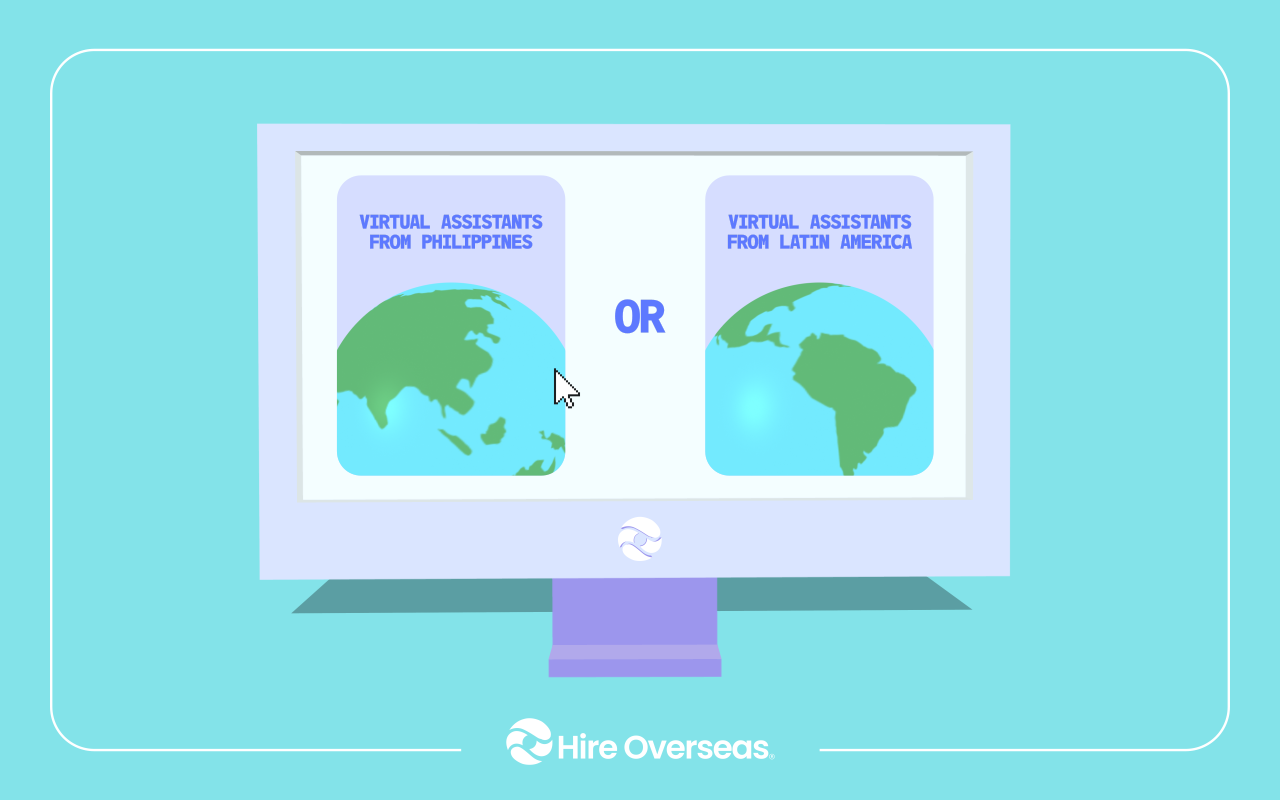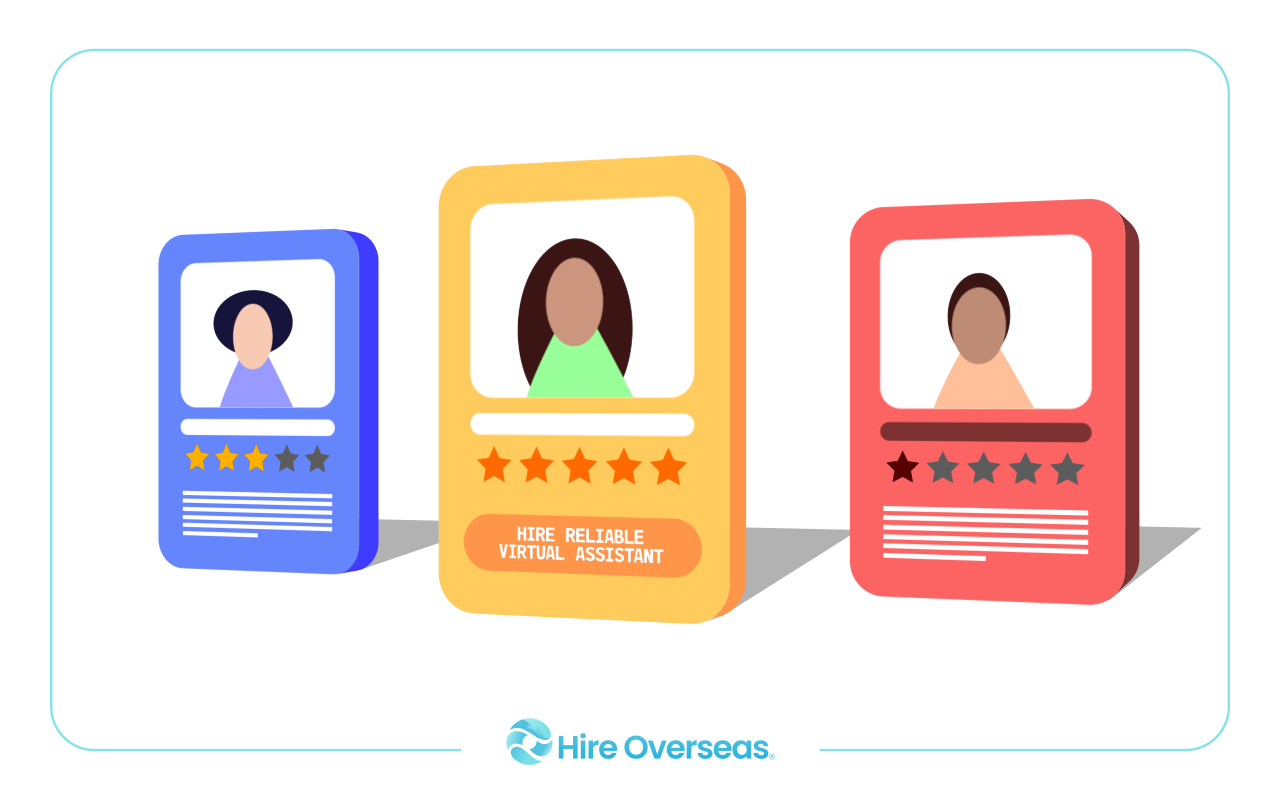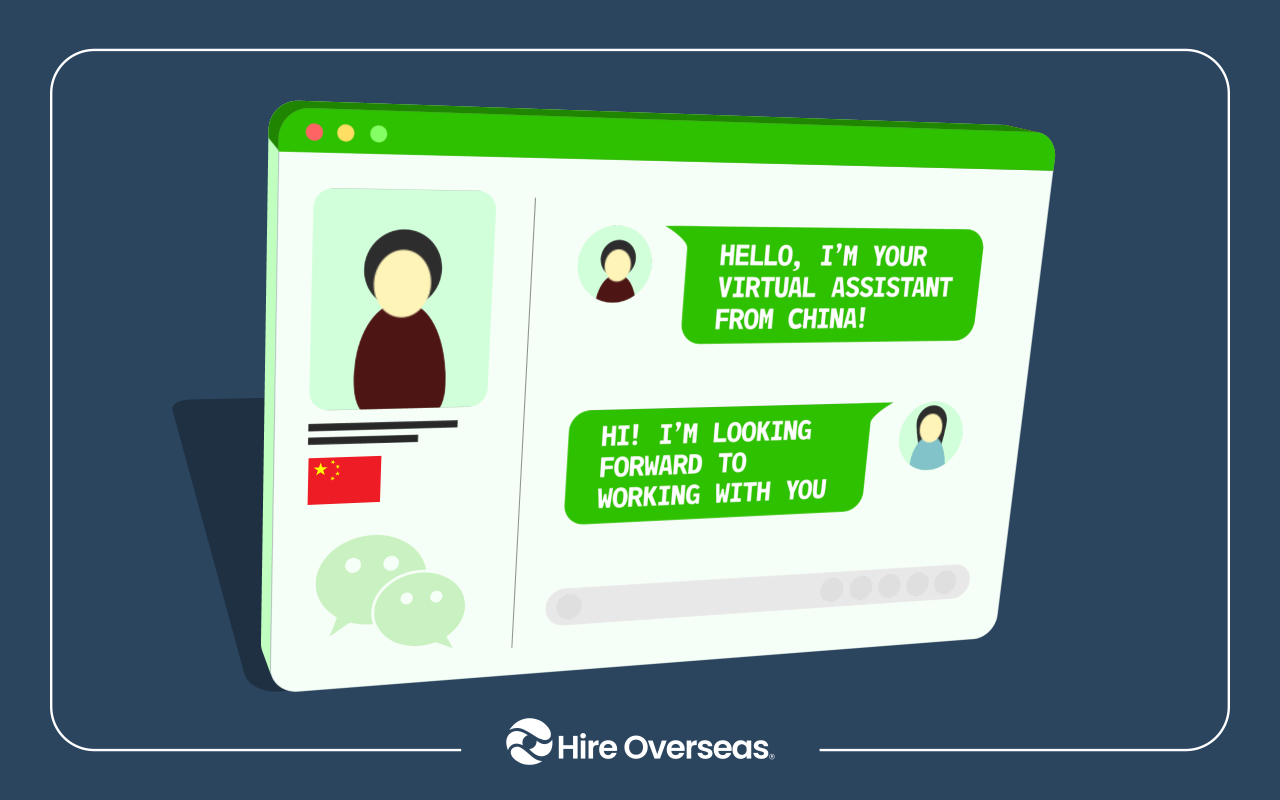Onboarding Remote Employees: Your Complete Guide to Success from Day One
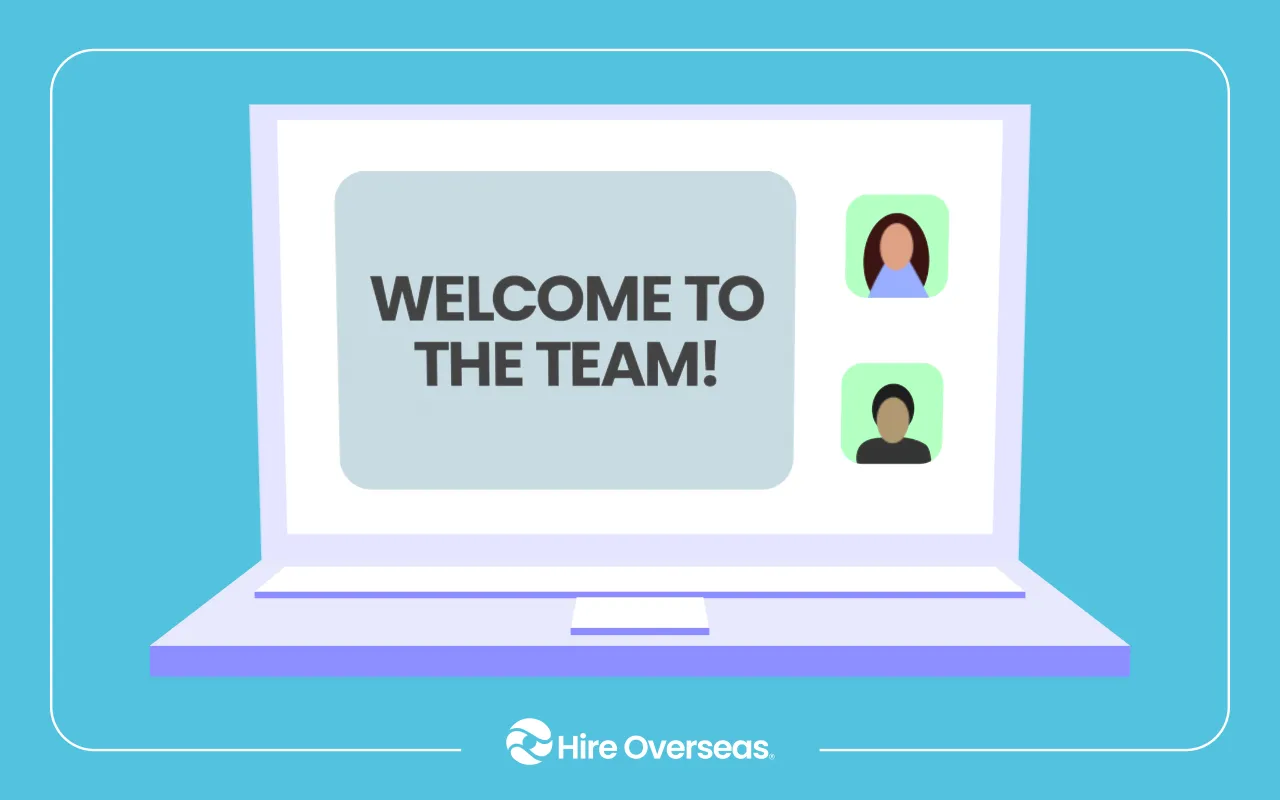
Remote hiring unlocks access to global talent but without the right onboarding, even the most qualified hire can feel lost, disconnected, or overwhelmed. Onboarding remote employees requires more than shipping a laptop and setting up a few calls. It’s about building a structured, supportive, and human-first experience that helps new hires feel confident, equipped, and connected—no matter where they are in the world.
In this complete guide, we’ll walk you through every phase of the remote onboarding process, from preboarding and Day One to 90-day milestones and continuous improvement. Whether you're scaling a distributed team or welcoming your first remote hire, this blueprint will help you create an onboarding experience that drives retention, productivity, and long-term success.
What Is Remote Onboarding?
Remote onboarding is the process of welcoming and integrating new employees into your organization when they’re working from a remote location—whether from home, a co-working space, or another country. Unlike traditional onboarding, which often involves in-person meetings, office tours, and face-to-face introductions, remote onboarding is entirely virtual and relies heavily on digital tools and intentional communication.
It covers everything from:
- Setting up the technical foundation (email, software, devices, security access)
- Introducing team members and organizational structure
- Providing training on tools, workflows, and expectations
- Immersing the new hire in your company’s culture and values
Why Remote Onboarding Matters
A great remote onboarding process does more than just check administrative boxes. It creates an engaging, structured, and supportive experience that helps employees feel confident and connected—right from day one.
It ensures that remote hires:
- Know what’s expected of them: Clear job responsibilities, key goals, and communication norms are outlined early on to reduce ambiguity.
- Have the tools and resources they need: All necessary hardware, software, passwords, and documentation are delivered in advance to eliminate frustrating delays.
- Understand your mission, culture, and team structure: They’re given insight into how the company operates, what it stands for, and how different departments collaborate.
- Feel welcomed and included: Through virtual meet-and-greets, onboarding buddies, and team check-ins, new hires are encouraged to build relationships and feel like part of the team.
In short, remote onboarding sets the tone for an employee’s journey—one that should feel intentional, human, and empowering.
Yet, according to Gallup, only 12% of employees strongly agree their company does a great job onboarding. The stakes are even higher when onboarding a remote employee, where miscommunication and isolation can derail early momentum.
Remote Onboarding Checklist: Your Four-Phase Blueprint
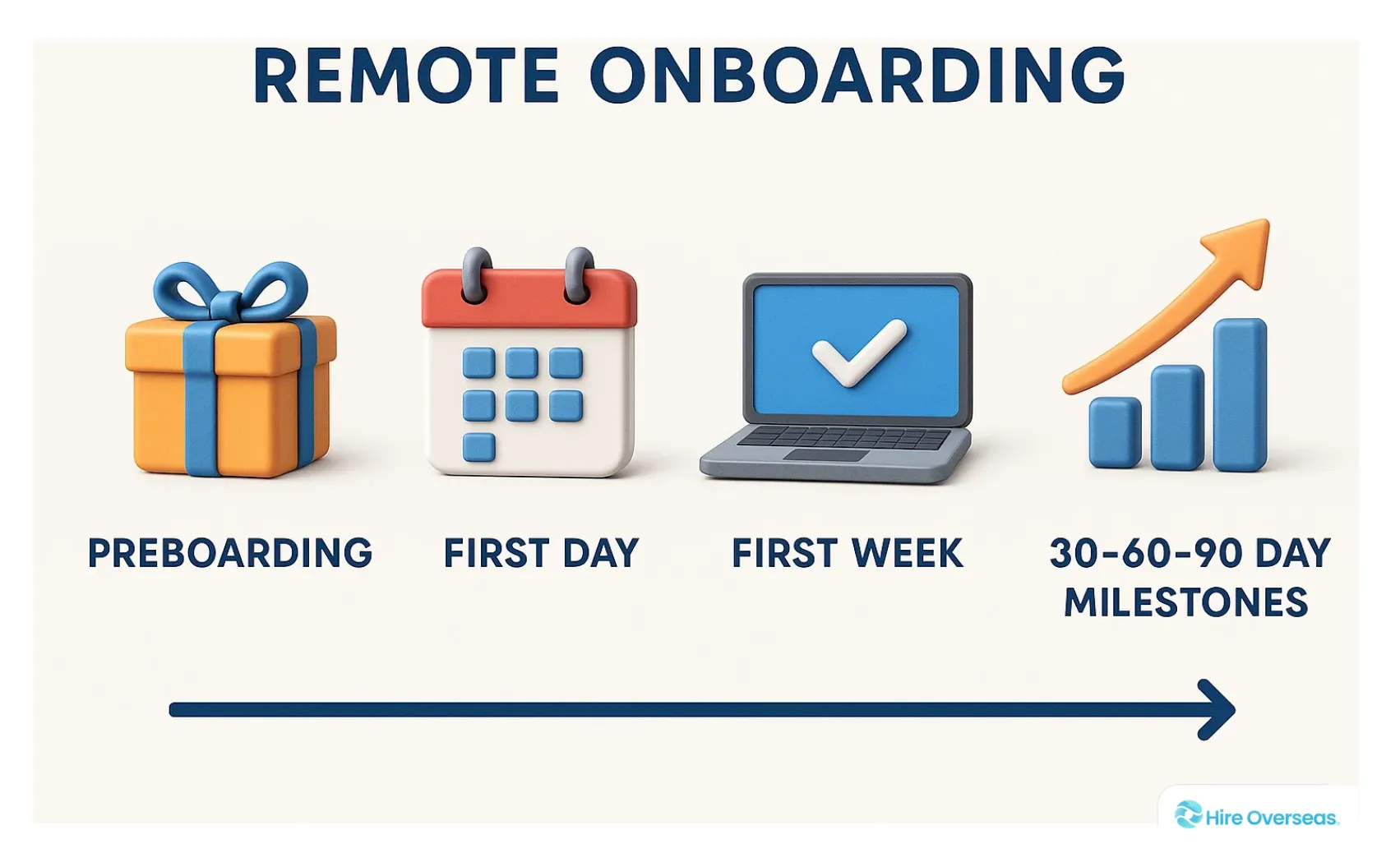
Four-phase remote onboarding checklist with icons for preboarding, Day One, Week One, and 90-day milestones.”
That’s why having a clear, repeatable, and well-structured remote onboarding process is essential. It ensures every new hire—no matter where they are in the world—feels welcomed, supported, and set up for success from day one. Use this remote onboarding checklist to guide your onboarding efforts and deliver a consistent and engaging experience across all stages of the employee journey.
A. Preboarding (1–2 Weeks Before Day One)
A strong remote onboarding process doesn’t begin on Day One—it starts well before, and it extends far beyond the first week. The goal of preboarding is to eliminate uncertainty and start building engagement before your new hire even logs in. Preparation here sets the tone for a smooth onboarding experience.
A thoughtful remote onboarding checklist starts here—before Day One—and shows that your company is organized, inclusive, and excited to welcome the new hire.
B. First Day
The first day is all about making your new team member feel seen, welcomed, and equipped. Prioritize connection and clarity over complexity.
Onboarding remote workers can feel disorienting without in-person interaction. Make your Day One welcoming, personal, and structured to reduce anxiety.
C. First Week
The first week is where confidence and clarity begin to build. Structure it around learning, social connection, and manageable wins.
This is also the ideal time to reinforce your remote onboarding best practices: consistent communication, documentation, and a supportive feedback loop.
D. 30‑60‑90‑Day Milestones
Effective onboarding remote employees means guiding them well beyond their first week. Use the 30/60/90-day framework to ensure they continue progressing with purpose.
30 Days: Learn & Connect
60 Days: Contribute & Collaborate
90 Days: Own & Grow
Following this structured remote onboarding checklist helps ensure your new hires don't just survive their first 90 days—they thrive.
Remote Onboarding Best Practices
While a well-structured checklist is essential, great remote onboarding goes beyond logistics. The best remote employee onboarding programs create clarity, connection, and culture—delivered through engaging experiences that set the tone for long-term success.
Here are the most effective best practices for onboarding remote employees, drawn from leading distributed teams and digital-first companies:
1. Design for Digital-First Experiences
The average new hire completes over 50 onboarding tasks—forms, trainings, intros, and more. Deliver this information through well-organized, digital-first formats that are easy to navigate and revisit.
- Use a centralized onboarding hub or intranet for resources, videos, and documentation
- Mix formats to avoid Zoom fatigue (e.g., short videos, interactive modules, PDFs, recorded tutorials)
- Include links to your company wiki, playbooks, and FAQs to encourage self-service learning
2. Balance Structure with Flexibility
Remote employees need autonomy—but not at the expense of clarity. Build flexibility into your remote onboarding process without overwhelming new hires.
- Spread onboarding across 1–2 weeks rather than cramming everything into the first few days
- Provide a clear agenda while leaving space for questions, reflection, and informal connections
- Allow time for asynchronous learning, especially across time zones
3. Make Culture and Belonging Explicit
In a physical office, new hires absorb company culture through observation. In a virtual environment, culture must be intentionally communicated.
- Share your origin story, mission, and values early and often
- Encourage new hires to join virtual social events, interest groups, or coffee chats
- Invite leadership to participate in onboarding to reinforce transparency and inclusion
4. Invest in Personalization
One of the most overlooked remote onboarding best practices is tailoring the experience to the individual.
- Personalize welcome messages, swag boxes, and check-in questions
- Match onboarding buddies based on personality, function, or shared interests
- Let new hires choose their learning pace (where possible) to promote engagement
5. Create Clear Role Pathways and Expectations
Without physical cues or spontaneous feedback, remote employees often feel unsure of what success looks like.
- Set clear expectations for the first 30, 60, and 90 days
- Define goals and KPIs collaboratively during onboarding
- Use shadowing, walkthroughs, and progress check-ins to reinforce understanding
6. Support Human Connection Early and Often
Onboarding remote workers can be isolating if social connections are overlooked. The more intentional you are, the faster new hires feel like part of the team.
- Schedule informal 1:1s and group intros across departments
- Assign a mentor or “welcome buddy” for casual support and company navigation
- Encourage managers to prioritize relational over transactional communication during early check-ins
7. Measure and Improve Continuously
Even the best remote onboarding checklist needs iteration. Collect qualitative and quantitative feedback from every new hire to improve the process.
- Send onboarding surveys after the first week and at the 30/60/90-day mark
- Ask about clarity, connection, speed, and support
- Implement small changes regularly to keep your remote onboarding program agile and effective
8. Treat Onboarding as a Retention Tool
Tips for onboarding remote employees don’t just apply to the first few days—they affect long-term retention and satisfaction. A great onboarding experience reinforces your employer brand, reduces turnover, and accelerates productivity.
When remote employees feel informed, equipped, and welcomed from the start, they’re more likely to stay, contribute, and thrive in their roles.
Remote Onboarding Models & Templates from GitLab, UC Berkeley, HR Cloud, and Hire Overseas
1. GitLab’s Remote Onboarding Framework
GitLab’s fully remote company culture centers around a public, handbook-first approach. Their internal "Onboarding Issue" serves as a single source of truth, ensuring transparency and reducing scattered communication. It uses a structured multi-week sequence and automates steps where possible. Their onboarding spans at least two weeks, plus a third week for job-specific training; new hires contribute small tasks gradually with no pressure to deliver from Day One The GitLab Handbook. The Onboarding Buddy Program pairs each new hire with a peer in a similar timezone. Buddies check daily progress on the onboarding issue, guide handbook navigation, and help with informal introductions.
2. HR Cloud (via HR Cloud Blog & Templates)
HR Cloud offers free onboarding templates, including editable checklists and process maps for remote hires. It emphasizes scalable, repeatable documentation and structured handovers to managers and support teams. Their guide covers every stage from preboarding through 90-day milestones, clearly assigning owners, timelines, and expected deliverables for each task.
3. University of California, Berkeley Onboarding Toolkit
UC Berkeley’s remote onboarding toolkit proposes batching no more than 3-4 meetings per day during a new hire’s first two weeks, to prevent burnout and overwhelm. Their toolkit also reinforces employing a buddy system—not just a peer mentor but someone who meets before Day One and continues multiple check-ins to support connection and onboarding clarity.
4. Hire Overseas Remote Onboarding Playbook
At Hire Overseas, onboarding isn’t just a checklist—it’s a curated experience designed to help remote contractors succeed from day one and thrive long term. Rooted in clarity, cultural alignment, and proactive support, the framework combines structured processes with people-first practices.
Key features include:
- Welcome & Orientation Hub: All new hires are introduced to a centralized onboarding workspace that includes:
- A step-by-step “Onboarding Process” email guide
- A “Welcome to Hire Overseas” orientation page
- Clear policies, including vacation and time-off documentation
- A role-based knowledge library for rapid onboarding by position
- How to Succeed Modules
- New hires receive curated guides that go beyond logistics, covering:
- Crushing Your First Day: Expectations, priorities, and tips to start strong
- Contractor Best Practices: Work habits, time tracking, and deliverables
- Bridging Cultural Differences: Insights to navigate cross-cultural communication
- Async Communication Guide: Best practices for global, remote-first collaboration
- Role-Specific Onboarding Tracks
- Contractors receive tailored onboarding paths depending on their position—whether they’re a Virtual Assistant, SEO Specialist, Social Media Manager, or Video Editor—ensuring every team member gets job-relevant tools, training, and expectations.
- Ongoing Coaching & Support
- Unlike static checklists, Hire Overseas embeds continued support:
- Regular check-ins with an account manager
- Performance reviews at 30, 60, and 90 days
- Optional coaching or training refreshers based on role or challenges
Hire Overseas’ model combines the documentation strength of GitLab, the structure of HR Cloud, and the pacing of UC Berkeley— a deeply human approach to onboarding remote employees at scale. Explore our full onboarding template here: Hire Overseas Onboarding Hub.
Summary Comparison: GitLab / HR Cloud / Berkeley vs. Hire Overseas
Onboarding Is Just the Beginning. Successfully onboarding remote employees lays the foundation—but long-term success depends on how you manage, support, and grow your distributed team.
Read: Managing Remote Teams – How to Lead and Support Your Distributed Workforce
How to Measure and Improve Remote Onboarding—One Hire at a Time

A strong remote onboarding process isn’t just built once and forgotten. It evolves over time, shaped by data, feedback, and the real experiences of your team. To truly unlock the potential of distributed hires, companies need to measure what’s working—and adapt where needed.
1. Set Clear Onboarding KPIs
Start by identifying what success looks like for your organization. Common remote onboarding KPIs include:
- Time to Productivity – How long does it take a new hire to contribute meaningful work?
- Buddy Engagement – Are onboarding buddies completing check-ins and supporting new hires consistently?
- 30/60/90-Day Milestones – Are new hires hitting key checkpoints aligned with their role?
- First-Year Retention Rate – Are remote hires staying and growing with the company?
Tracking these metrics over time gives you a baseline for improvement.
2. Gather Feedback from Multiple Angles
Don’t rely on HR alone to evaluate onboarding. Loop in:
- New hires – Use pulse surveys and informal interviews to collect feedback in real time.
- Team leads – Ask managers how well new hires integrate into workflows and culture.
- Onboarding buddies – They often spot early red flags or confusion that others miss.
Capture both quantitative scores (e.g. 1–10 ratings) and qualitative input (“What’s one thing we could improve?”).
3. Use Onboarding Data to Improve Processes
Feedback without action leads to frustration. When patterns emerge—like confusion around tools, bottlenecks in IT setup, or unclear expectations—revise your onboarding materials and flow. Document your learnings in a centralized place like an internal wiki or onboarding playbook. At Hire Overseas, we recommend reviewing and updating onboarding templates at least once per quarter, especially if you're hiring across multiple time zones or countries.
4. Support a Culture of Iteration
Make continuous improvement part of your onboarding DNA. Let new hires know their input shapes the future experience for others. Consider adding a final task like:
“Suggest one improvement to the onboarding process” at the end of their 90-day journey.
This reinforces your commitment to listening and helps build a culture of ownership—even from day one.
Remote onboarding isn't static. It's a living system that should grow alongside your team. By measuring what matters, listening actively, and refining regularly, your company can create a world-class onboarding experience—no matter where your team is based.
Common Challenges in Remote Onboarding—and How to Overcome Them
Remote onboarding offers flexibility and global reach, but it also comes with a unique set of hurdles that can impact a new hire’s experience and productivity. Here’s how companies—especially distributed and remote-first teams—can address the most frequent pitfalls:
1. Uncertainty Around Who to Ask for Help
New remote employees often struggle with something surprisingly simple: figuring out who to turn to with questions. Without hallway chats or physical proximity, it’s easy to feel lost—even with the best onboarding documentation.
Solution: Assign an onboarding buddy or peer mentor. This creates a clear point of contact for informal questions, builds early relationships, and gives new hires a soft landing. Ideally, the buddy should be in a similar time zone and role so that check-ins feel natural, not forced.
2. Technical Setbacks and Delays
From delayed laptop shipments to login issues, even the best-laid tech plans can hit snags. The lack of on-site IT support can turn small hiccups into major bottlenecks for productivity.
Solution: Build a preboarding checklist that includes equipment shipping, system access, and software setup—well ahead of Day One. Ensure your IT support is proactive, reachable across time zones, and has resources dedicated to supporting new hires in their first few weeks.
3. Silence Around What’s Not Working
Remote hires may hesitate to speak up when something is unclear or frustrating. Without body language or casual feedback loops, issues can fester silently.
Solution: Actively ask for feedback during and after the onboarding process. Use short weekly surveys, informal check-ins, and one-on-ones to capture real-time insights—and show that feedback actually leads to change.
4. Lack of Social Connection
Remote roles can feel isolating, especially for those transitioning from traditional office settings. Without informal bonding, new hires may feel like outsiders.
Solution: Design socialization into your onboarding. Schedule virtual coffee chats, Slack intros, and team bonding calls. Encourage team leads to model informal communication and invite new hires into casual channels. Even light-hearted interactions can help build strong distributed teams.
5. Missing Structure for Informal Communication
In remote environments, “spontaneous” socializing needs structure. Without a plan, informal conversations simply don’t happen—and new hires miss out on the cultural context of the team.
Solution: Formalize informal communication. Add social tasks into onboarding templates like:
- “Schedule 3 virtual coffee chats this week”
- “Introduce yourself in the team channel”
- “Join a company-wide hangout or game session”
These small touches help make a big company feel smaller—and more welcoming.
Hire Overseas Tip: Don’t wait until onboarding is over to ask how it’s going. Create a feedback loop from Day One, and make sure new hires know their input matters. A thoughtful remote onboarding process can boost retention, accelerate ramp-up time, and build lasting loyalty.
The First 90 Days Are Just the Beginning
Remote onboarding isn’t a one-size-fits-all checklist—it’s a critical, ongoing experience that shapes how new hires engage with your team, culture, and mission. A thoughtful, well-structured onboarding journey builds clarity, trust, and momentum from Day One.
By combining digital-first tools, social connection, and measurable feedback loops, you create an environment where remote employees don’t just survive—they thrive. And with every new hire, you have the opportunity to refine, personalize, and strengthen your onboarding process.
At Hire Overseas, we believe great onboarding is the foundation for great remote teams. If you’re ready to build a distributed workforce that performs from anywhere, it starts with getting onboarding right.
Need Help Finding the Right Remote Hire?
Whether you need a virtual assistant, developer, marketer, or bookkeeper, we’ll help you find, vet, and onboard the perfect match.
Get a Free Hiring Consultation. Discover pre-vetted candidates and personalized hiring support—no upfront commitment.
FAQs about Onboarding Remote Employees
What software tools are best for onboarding remote employees?
Top tools include:
- Communication: Slack, Microsoft Teams, Zoom
- Project Management: Asana, Trello, Notion
- HR & Onboarding: BambooHR, Sapling, Deel, Gusto
- Knowledge Sharing: Confluence, Guru, Trainual
At Hire Overseas, we use Notion as our centralized onboarding hub to organize training materials, checklists, company documentation, and team resources in one accessible, easy-to-navigate workspace. The best tools are those that integrate smoothly with your existing workflows, support asynchronous collaboration, and work effectively across time zones.
What’s the difference between virtual onboarding and in-person onboarding?
Virtual onboarding is fully remote and relies on digital platforms for communication, training, and culture-building. In-person onboarding allows for real-time interaction and informal bonding. Virtual onboarding requires more structured communication and intentional culture-sharing.
Can remote onboarding be just as effective as in-person onboarding?
Yes, when well-designed. Remote onboarding can be just as impactful—if not more—by leveraging documentation, asynchronous learning, and intentional relationship-building. The key is clear structure, human connection, and consistent follow-up.
How do you onboard remote employees across different time zones?
Stagger onboarding sessions to accommodate time zones, use asynchronous tools (recorded videos, digital handbooks), and allow flexible scheduling for social meetups and training. Assigning a buddy in a similar time zone also helps bridge the gap.
What should a remote onboarding welcome email include?
A strong welcome email should include:
- Start date, time, and time zone
- Agenda for the first day or week
- Links to key resources or tech setup instructions
- Contact information for HR, IT, or the onboarding buddy
- A warm message to help them feel included and excited
What’s the role of an onboarding buddy in a remote setting?
An onboarding buddy serves as a go-to person for informal questions, social integration, and culture acclimation. In remote teams, buddies reduce the sense of isolation and help new hires feel supported from day one.
Unlock Global Talent with Ease
Hire Overseas streamlines your hiring process from start to finish, connecting you with top global talent.


